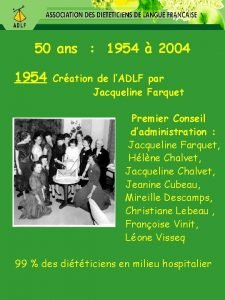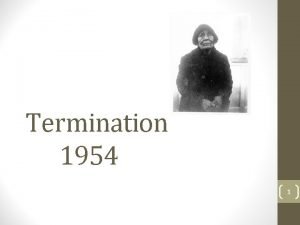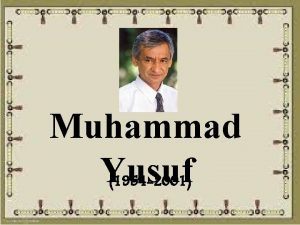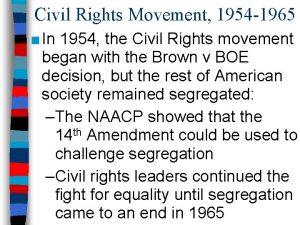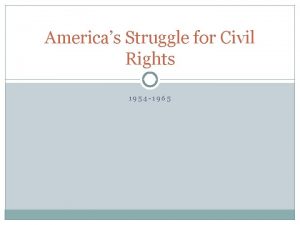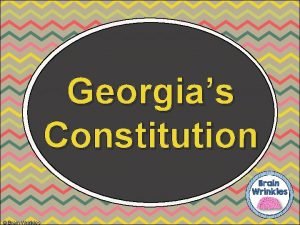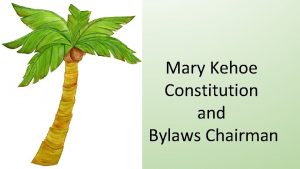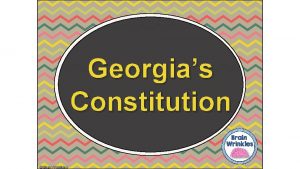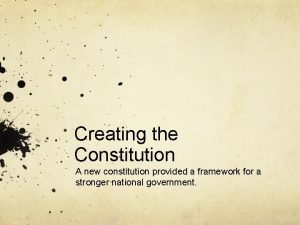The Lyttleton Constitution 1954 The new constitution that













- Slides: 13

The Lyttleton Constitution, 1954 The new constitution that came into existence in 1954 was named after then Secretary of State for the Colonies, Oliver Lyttleton. It came into existence as a successor to the Macpherson constitution and was intended to address some the shortcomings of the previous constitution. In spite of the fact that Nigerians were actually, for the first time ever, involved in the processes that led to the drafting and adoption of the previous constitution,

the fact was that it did not go far enough to satisfy the aspirations of Nigerians who were already agitating for increased autonomy and self-government. • As a matter of fact, the desire for local autonomy and eventual independence was expressed in the House of Representatives by Hon. Anthony Enahoro in 1953 when he moved a motion asking for independence to be granted to Nigeria by 1956.

Even though the representatives of the Northern Region objected to the motion and asserted that the North was not ready for independence by 1956 as proposed by Anthony Enahoro, the motion nonetheless had fired the imagination of Nigerians to begin to plan for eventual independence, which came later in 1960. The importance or significance of this political development is the increasing awareness that Nigerians must be further involved in the management of their own affairs and that granting greater local autonomy had thus become inescapable.

• Without doubt, this development influenced the colonial administration to begin the process of designing a new constitution that would emphasize greater regional autonomy and federalism as the best political arrangement for governing a multi-ethnic country like Nigeria.

By the early 1950 s, strong political parties had begun to emerge and their nationalists activities and demands could no longer be ignored by the colonial authorities. The major parties include the Action Group (AG) (which had emerged from the Yoruba socio-cultural organization known as the Egbe Omo Oduduwa), the National Congress of Nigeria and Cameroon later changed to National Congress of Nigerian Citizens (NCNC), the Northern Peoples Congress (NPC). These three political parties also dominated the three Regions, i. e. , the AG in the Western Region, the NCNC in the Eastern Region, and the NPC in the Northern Region.

• The parties performed the main functions of articulating, aggregating and ventilating the political aspirations of their members. • They also championed the interests of their regions as well. From that point on, it was the political parties that represented the interests of the people that the colonial authorities had to reckon with.

It is important to emphasize that the changes that were taking place were consequences of the agitations that had been made by the Nigerians who had earlier been elected into the House of Representatives under the previous Macpherson constitution. They had succeeded in increasing the tempo of nationalist agitation for reforms that would lead to eventual independence.

• These and other related political developments necessitated the convening a constitutional conference by the British government in London in 1953, at which the political parties made known their general and collective dissatisfaction with the shortcomings of the existing Macpherson Constitution, and thereby presented their own proposals for a new one. This gave birth to the Lyttleton Constitution.

Major Highlights of the Lyttleton Constitution: - The creation of three distinct legislative lists, i. e. , allocation of specified subjects exclusively to the federal government, list of concurrent subjects to both federal and regional governments, and residual powers to regional governments - Creation of unicameral legislature, i. e. , the House of Representatives made up of 184 members (50% each representing the North and South) who were not answerable to the Regional houses of assembly

- A central executive of 13 ministers (3 from each region recommended by the majority party, 1 from Cameroon, and 3 ex-officio members) with individual ministerial responsibility - A Premier to be at the head of the government of each Region - a Governor-General for the whole of the federation of Nigeria and a Governor for each Region

- a regionalized Civil Service, Judiciary, Commodity Marketing Boards, etc to exist side by side with similar federal bodies - Northern Cameroons was made an integral part of Northern Nigeria, while Southern Cameroon which was originally a part of Eastern Region was now given a quasifederal status - Lagos was removed from Western Region and given the status of Federal Capital under the federal government

- Self-government to be granted by 1956 to the Regions that desired it, but full independence was not decided upon - Constitutional conference to be convened by 1956 to review the performance of the new constitution.

• Overall, we can assert that the constitution gave greater autonomy and powers to the Regions, almost giving them sovereign status as if they were independent entities within Nigeria. It thus made Nigeria a much stronger federation than what the previous Macpherson Constitution had accomplished. • #######
 Tôn thất thuyết là ai
Tôn thất thuyết là ai Ngoại tâm thu thất chùm đôi
Ngoại tâm thu thất chùm đôi Chiến lược kinh doanh quốc tế của walmart
Chiến lược kinh doanh quốc tế của walmart Gây tê cơ vuông thắt lưng
Gây tê cơ vuông thắt lưng Block xoang nhĩ là gì
Block xoang nhĩ là gì Tìm vết của đường thẳng
Tìm vết của đường thẳng Sau thất bại ở hồ điển triệt
Sau thất bại ở hồ điển triệt Thơ thất ngôn tứ tuyệt đường luật
Thơ thất ngôn tứ tuyệt đường luật Con hãy đưa tay khi thấy người vấp ngã
Con hãy đưa tay khi thấy người vấp ngã Thơ thất ngôn tứ tuyệt đường luật
Thơ thất ngôn tứ tuyệt đường luật Nc constitution vs us constitution
Nc constitution vs us constitution Constitution what is constitution
Constitution what is constitution The constitution lesson 1 principles of the constitution
The constitution lesson 1 principles of the constitution Texas constitution vs us constitution
Texas constitution vs us constitution














